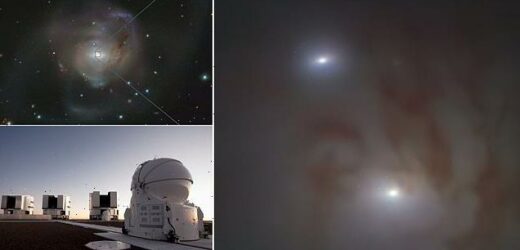Closest pair of supermassive black holes are spotted just 1,600 light years apart in the sky – and are spiralling toward a cataclysmic collision, scientists say
- Closest pair of supermassive black holes to Earth ever seen have been observed
- Scientists said the two objects were about 89 million light-years away from Earth
- They are 1,600 light-years apart and will eventually merge into a giant black hole
- The European Southern Observatory’s Very Large Telescope helped detect them
The closest pair of supermassive black holes to Earth ever seen have been observed by astronomers.
They said the two objects — which are just 1,600 light-years apart — also have a much smaller separation than any other previously spotted pair of supermassive black holes and will eventually merge into one giant black hole.
Scientists detected them using the European Southern Observatory’s Very Large Telescope (VLT) and said they were about 89 million light-years away from Earth.
Discovery: The closest pair of supermassive black holes to Earth ever seen have been observed by astronomers. Two bright galactic nuclei, each consisting of a dense group of stars with a supermassive black hole at its centre, are pictured in a close up image above
WHAT IS THE NGC 7727 GALAXY AND HOW FAR AWAY IS IT?
NGC 7727 is a spiral galaxy in the constellation Aquarius that is about 89 million light-years away from Earth.
It was first discovered by William Herschel in 1785.
The galaxy has numerous star streams and plumes associated with it, which astronomers believe could be the result of a merger with another spiral galaxy about one billion years ago.
At the heart of it is a supermassive black hole that has a mass almost 154 million times that of our sun.
This is paired with a separate black hole, just 1,600 light-years away, which astronomers say is 6.3 million solar masses.
The bigger black hole, located at the heart of the NGC 7727 galaxy in the constellation Aquarius, was found to have a mass almost 154 million times that of our sun, while its companion is 6.3 million solar masses.
Experts were able to determine these masses by looking at how the gravitational pull of the black holes influences the motion of the stars around them.
According to the researchers, it is the first time that masses have been calculated this way for a pair of supermassive black holes.
The feat was made possible thanks to the close proximity of the system to Earth and the detailed observations researchers obtained using the VLT at the Paranal Observatory in Chile and additional data from the Hubble Space Telescope.
Astronomers suspected that the galaxy hosted the two black holes, but they had not been able to confirm their presence until now.
That is because we do not see large amounts of high-energy radiation coming from their immediate surroundings, which would otherwise give them away.
‘Our finding implies that there might be many more of these relics of galaxy mergers out there and they may contain many hidden massive black holes that still wait to be found,’ said lead researcher Karina Voggel, from the University of Strasbourg.
‘It could increase the total number of supermassive black holes known in the local universe by 30 per cent.’
The search for similarly hidden supermassive black hole pairs is expected to make a great leap forward with the new Extremely Large Telescope (ELT), which is set to start operating later this decade in Chile’s Atacama Desert.
‘This detection of a supermassive black hole pair is just the beginning,’ said co-author Steffen Mieske, an astronomer at the European Southern Observatory in Chile.
‘With the HARMONI instrument on the ELT we will be able to make detections like this considerably further than currently possible.
‘ESO’s ELT will be integral to understanding these objects.’
The European Southern Observatory was established as an intergovernmental organisation in 1962.
Today it is supported by 16 member states including France, Germany, Spain and the United Kingdom, along with the host state of Chile.
The black hole discovery has been published in the journal Astronomy & Astrophysics.
THE VERY LARGE TELESCOPE IS A POWERFUL GROUND-BASED INSTRUMENT IN CHILE
The European Southern Observatory (ESO) built the most powerful telescope ever made in the Atacama Desert of northern Chile.
It is called the Very Large Telescope (VLT) and is widely regarded as one of the most advanced optical instruments ever made.
It consists of four telescopes, whose main mirrors measures 27 feet (8.2 metres) in diameter.
There are also four movable six feet (1.8 metre) diameter auxiliary telescopes.
The large telescopes are called Antu, Kueyen, Melipal and Yepun.
The European Southern observatory (ESO) built the most powerful telescope ever made in the Atacama Desert of northern Chile and called it the Very Large Telescope (VLT).
The first of the Unit Telescopes, ‘Antu’, went into routine scientific operations on April 1, 1999.
The telescopes can work together to form a giant ‘interferometer’.
This interferometer allows images to be filtered for any unnecessary obscuring objects and, as a result, astronomers can see details up to 25 times finer than with the individual telescopes.
It has been involved in spotting the first image of an extrasolar planet as well as tracking individual stars moving around the supermassive black hole at the centre of the Milky Way.
It also observed the afterglow of the furthest known Gamma Ray Burst.
Source: Read Full Article




